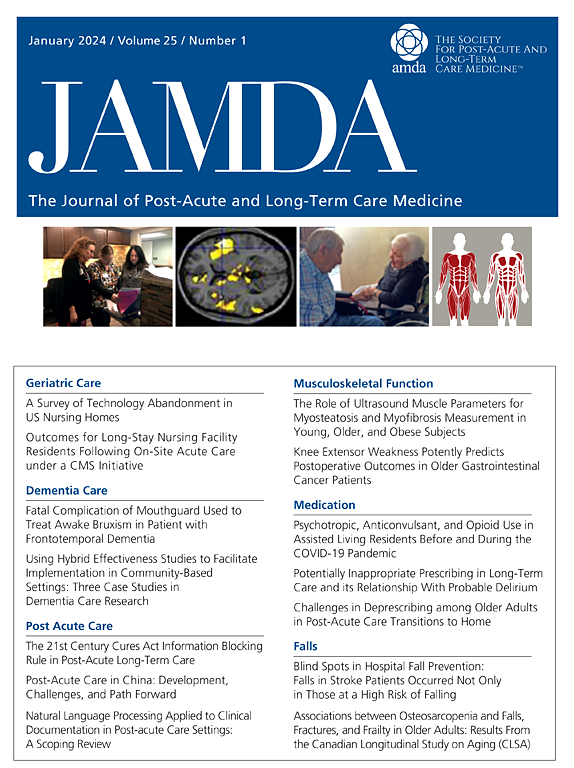Measurement of Quality in Assisted Living in the United States of America: A Scoping Review
IF 4.2
2区 医学
Q2 GERIATRICS & GERONTOLOGY
Journal of the American Medical Directors Association
Pub Date : 2025-01-01
DOI:10.1016/j.jamda.2024.105355
引用次数: 0
Abstract
Objectives
To identify different approaches (unique domains) and indicators to evaluate quality in assisted living communities in the United States.
Design
Scoping review supplemented with key informant and technical panel guidance.
Setting and Participants
Assisted living settings and residents.
Methods
We obtained feedback on our review protocol and search strategy from key informants with expertise in AL quality, including feedback on a supplementary gray literature search for relevant non–peer-reviewed literature (such as nonempirical policy briefs). We scanned MEDLINE and CINAHL databases for peer-reviewed literature published from 2009 through 2019 assessing quality in assisted living in the United States. We synthesized evidence using the Donabedian framework and presented our analyses in 2 expert panel discussions for additional insights.
Results
We screened 833 abstracts, of which 49 studies met our selection criteria. Gray literature search yielded an additional 45 non–peer-reviewed sources. Nine unique domains were assessed: (1) resident quality of life, (2) resident and family satisfaction, (3) staffing and staff-related outcomes, (4) resident safety, (5) resident health outcomes, (6) care planning and integration, (7) physical and social environment, (8) service availability, and (9) core values and philosophy. Resident quality of life and satisfaction were the most prioritized domains in published literature, key informant interviews, and expert panel discussions. Domains such as staffing, safety, resident health outcomes, care planning, and integration were identified as vitally important for the increasing clinical and sociodemographic heterogeneity in the resident population. Expert panels emphasized the importance of including residents’ voice in the quality measures development process.
Conclusions and Implications
Lack of standardized measurement of quality impedes provision of person-centered, value-based care in US-based assisted living settings. Our comprehensive list of domains and indicators should inform future concerted efforts to develop and incorporate standardized quality measurement as part of routine practice in assisted living communities in the United States.
美国辅助生活质量的衡量:范围审查》。
目标:确定评估美国辅助生活社区质量的不同方法(独特领域)和指标:确定评估美国生活辅助社区质量的不同方法(独特领域)和指标:设计:范围审查,辅以关键信息提供者和技术小组指导:环境和参与者:生活辅助设施和居民:我们从具有辅助生活质量专业知识的关键信息提供者那里获得了对我们的综述方案和检索策略的反馈,包括对相关非同行评审文献(如非实证性政策简报)的补充灰色文献检索的反馈。我们在 MEDLINE 和 CINAHL 数据库中搜索了 2009 年至 2019 年间发表的评估美国辅助生活质量的同行评审文献。我们使用多纳比德框架对证据进行了综合,并在 2 次专家小组讨论中介绍了我们的分析,以获得更多见解:我们筛选了 833 份摘要,其中 49 项研究符合我们的筛选标准。通过灰色文献检索,我们又找到了 45 篇未经同行评审的资料。我们评估了九个独特的领域:(1) 居民生活质量;(2) 居民和家庭满意度;(3) 人员配备和员工相关结果;(4) 居民安全;(5) 居民健康结果;(6) 护理规划和整合;(7) 物理和社会环境;(8) 服务可用性;(9) 核心价值和理念。在发表的文献、关键信息提供者访谈和专家小组讨论中,住院患者的生活质量和满意度是最优先考虑的领域。人员配备、安全性、住院患者的健康状况、护理规划和整合等领域被认为对住院患者日益增长的临床和社会人口异质性至关重要。专家小组强调了将住院医师的意见纳入质量衡量标准制定过程的重要性:缺乏标准化的质量衡量标准阻碍了在美国的生活辅助设施中提供以人为本、以价值为基础的护理服务。我们的综合领域和指标清单应为未来的共同努力提供参考,以开发标准化的质量测量方法并将其纳入美国生活辅助社区的日常实践中。
本文章由计算机程序翻译,如有差异,请以英文原文为准。
求助全文
约1分钟内获得全文
求助全文
来源期刊
CiteScore
11.10
自引率
6.60%
发文量
472
审稿时长
44 days
期刊介绍:
JAMDA, the official journal of AMDA - The Society for Post-Acute and Long-Term Care Medicine, is a leading peer-reviewed publication that offers practical information and research geared towards healthcare professionals in the post-acute and long-term care fields. It is also a valuable resource for policy-makers, organizational leaders, educators, and advocates.
The journal provides essential information for various healthcare professionals such as medical directors, attending physicians, nurses, consultant pharmacists, geriatric psychiatrists, nurse practitioners, physician assistants, physical and occupational therapists, social workers, and others involved in providing, overseeing, and promoting quality

 求助内容:
求助内容: 应助结果提醒方式:
应助结果提醒方式:


